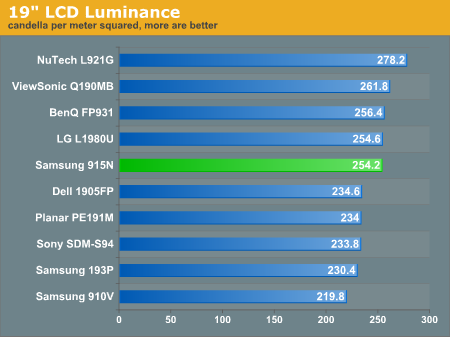Samsung SyncMaster 915N: 8ms Response Times
by Kristopher Kubicki on May 25, 2005 12:05 AM EST- Posted in
- Displays
Quantitative Analysis
For the duration of this review, we connected the Samsung SyncMaster 915N to a Radeon X800 Pro with factory default settings on the Analog connection unless stated otherwise. Brightness has been set to maximum as well (with the exception of some of the application tests). Our lab is set up in a controlled white room with two incandescent and two florescent light sources.Luminance
Brightness ranked as one of our most important display qualities. In a well lit environment, a bright display will actually offer less strain on your eyes than a dimly lit one. Below, you can see a comparison of the brightness for each of our LCD monitors.

Our Contrast Ratio
We will use the same observation from the 19" LCD Roundup several months ago. Using PreCal and our ColorVision Spyder, we will measure the luminance of a pure white image and a pure black image on the LCD monitor. The observed contrast ratio is simply the highest recorded luminance divided by the lowest. All measurements are in candela per meter squared; larger contrast ratios are more desirable.| Observed Contrast Ratio | |||
| Highest Recorded (white image) | Lowest Recorded (black image) | Observed Contrast Ratio | |
| BenQ FP931 | 256.4 | 3.6 | 71.2 |
| Dell 1905FP | 234.6 | 2.6 | 90.2 |
| LG L1980U | 254.6 | 2.8 | 91.0 |
| NuTech L921G | 278.2 | 2.6 | 107.0 |
| Planar PE191M | 234.0 | 3.0 | 78.0 |
| Samsung 193P | 230.4 | 2.2 | 104.7 |
| Samsung 910V | 219.8 | 2.6 | 84.5 |
| Samsung 915N | 264.2 | 2.6 | 101.6 |
| Sony SDM S94 | 233.8 | 3.0 | 77.9 |
| ViewSonic Q190MB | 261.8 | 2.6 | 100.7 |
Samsung actually doesn't perform too badly with regard to contrast ratio. Although our equipment is not particularly sensitive on the low light luminance recordings, the disparity between the Samsung 915N and the Dell 1905FP is more than apparent. The Samsung is the brighter monitor, but it cannot produce a dark enough of an image that many of our other displays can. You may recall that the Hitachi CML174B had very similar problems two years ago when it was the only 16ms display available.
With some applications, the "wash out" effect is slightly more prevalent on the SyncMaster 915N than on other displays. We use Dell 2005FPs almost exclusively for day-to-day operations in the lab, and going from one of those displays to the 915N is almost painful. However, when compared to the ViewSonic Q190MB and the NuTech L921G, the result is fairly comparable. The Samsung 193P and Dell 1905FP (which both use the same 25ms Samsung panel) lead the pack for 19" displays as far as real world comparison with the contrast ratio goes - even if the NuTech unit scored slightly higher in our Observed Contrast Ratio chart.










43 Comments
View All Comments
Denial - Wednesday, May 25, 2005 - link
This will be a nice replacement for the 193s I'm staring at.RaidenSix - Wednesday, May 25, 2005 - link
There's already a DVI version of this monitor - 930B.Chapbass - Wednesday, May 25, 2005 - link
first post! har har...typo on this line in the conclusion:
comparison to all of the displays htat we have reviewed in the past
in all, pretty cool review...yet another lcd option to replace my old scratched 21" crt...